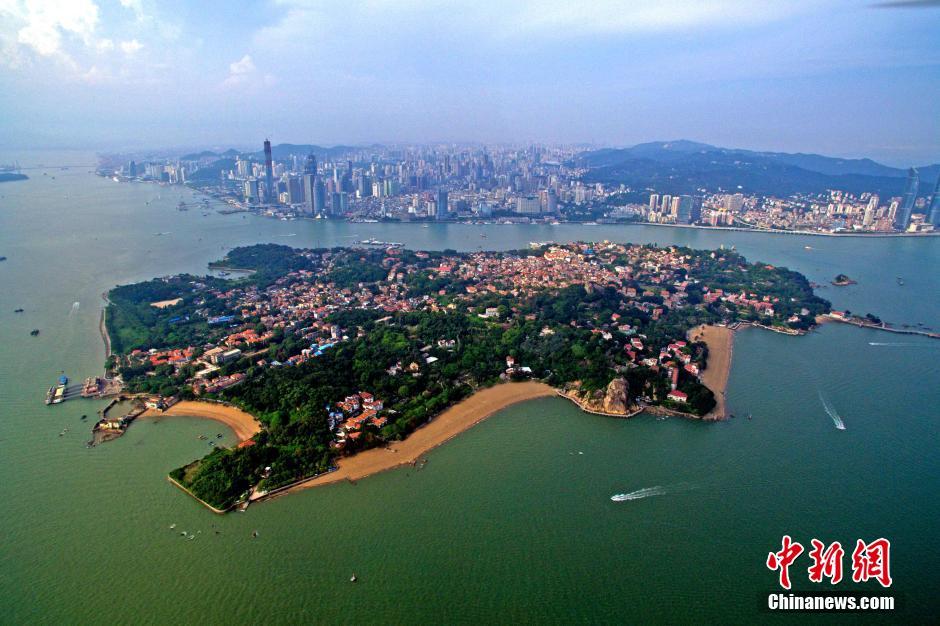


Gulangyu Island
China has made a name for itself in recent years for creating spectacular futuristic architecture. Therefore, it came as a huge surprise that a country, which is so well-known for its projects on a gigantic scale, would make efforts to preserve a measly 1.87 kilometer-squared island.
Gulangyu Island (also known as Kulangsu Island), faces the city of Xiamen from across the 600-meter-wide Lujiang Strait, in Southeast China’s Fujian province. The tiny island, with a population of around 20,000 people, is one of very few pedestrian islands in the world, completely free of cars and even bicycles. It was last year granted the status of UNESCO World Cultural Heritage site.
The island was seen to be the gateway for Sino-foreign exchanges during the 18th century, with nearly 13 countries having some form of settlement during various periods. While many of these settlements would have been hostile to the Chinese state, it is surprising to see the efforts that the Chinese government has taken to preserve the structures which represent the fusion of diverse values and culture during the early stages of Asian globalization.
As a visitor setting foot on the island, after the 8-minute ferry ride from downtown Xiamen, the first thing that one notices is the lush greenery, knobbly banyan trees, the paved cobbled alleys and complete absence of motorized vehicles.
The 931 historical mansions constructed in a European style during the 19th century are another unique presence. Almost every structure on the island has a legacy, while some of the most iconic and haunting include the former Japanese consulate which also housed a police station. The way that this structure has been preserved speaks a lot about China’s efforts to maintain its history and cultural heritage.
Another major architectural highlight is a Gothic-style Catholic Church, which was designed by a Spanish architect in 1917 and constructed by craftsmen from the surrounding area. The church is aligned north-south rather than the normal west-east due to spacial constraints.
The Shuzhuang Garden is another interesting place. Constructed in 1913 by a wealthy Taiwanese merchant, the design of the garden incorporates a total of 12 landscapes. These create an idealized landscape stressing harmony between human beings and their surroundings.
The presence of the piano museum, which preserves the legacy of classical music, is another highlight of the island. Even though the piano in its present form didn't arrive on the island until the early 20th century, the region saw the proliferation of pianos, with over 500 such instruments finding their way onto the island by the 1950s. The island is also the birthplace of many of the world’s leading pianists. The piano museum was opened to honor this instrument thanks to the largesse of Hu Youyi, a private collector who donated over 100 pianos to the museum.
The island became known as the "Island of Pianos," and it's commendable that such a museum was set up in China rather than in a Western country, where the instrument originated.
Visiting this island allows us not only to enjoy the beauty of this culturally rich site but also gives us an insight into the Chinese tradition of being inclusive and having the courage to embrace and imbibe different values and cultures.
Zeeshan Shaikh is a senior assistant editor at The Indian Express.

 Award-winning photos show poverty reduction achievements in NE China's Jilin province
Award-winning photos show poverty reduction achievements in NE China's Jilin province People dance to greet advent of New Year in Ameiqituo Town, Guizhou
People dance to greet advent of New Year in Ameiqituo Town, Guizhou Fire brigade in Shanghai holds group wedding
Fire brigade in Shanghai holds group wedding Tourists enjoy ice sculptures in Datan Town, north China
Tourists enjoy ice sculptures in Datan Town, north China Sunset scenery of Dayan Pagoda in Xi'an
Sunset scenery of Dayan Pagoda in Xi'an Tourists have fun at scenic spot in Nanlong Town, NW China
Tourists have fun at scenic spot in Nanlong Town, NW China Harbin attracts tourists by making best use of ice in winter
Harbin attracts tourists by making best use of ice in winter In pics: FIS Alpine Ski Women's World Cup Slalom
In pics: FIS Alpine Ski Women's World Cup Slalom Black-necked cranes rest at reservoir in Lhunzhub County, Lhasa
Black-necked cranes rest at reservoir in Lhunzhub County, Lhasa China's FAST telescope will be available to foreign scientists in April
China's FAST telescope will be available to foreign scientists in April